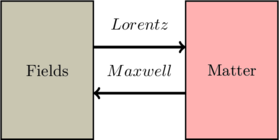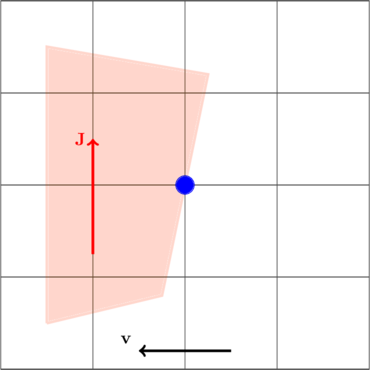Motivations
One important and fair question is
“Why are you interested in the principles of computational electromagnetism, which is a rather mature field?”
I have three main reasons.
Firstly I am interested in the two way interaction of electromagnetic fields with matter: Fields influence matter and matter influence the fields. The effect of the electric and magnetic fields (![]() ) on a point charge moving with a velocity
) on a point charge moving with a velocity ![]() is described by Lorentz force:
is described by Lorentz force:
![]()
Lorentz force, along with other forces, determine the motion of the particle. On the other hand, a moving charge creates a current (charge flow). In general if a charge has a volumetric distribution ![]() and moving with a velocity
and moving with a velocity ![]() , then the current density becomes
, then the current density becomes
![]()
for a point charge ![]() becomes
becomes ![]() . The current density
. The current density ![]() in turn changes the field according to Maxwell’s equations:
in turn changes the field according to Maxwell’s equations:
![]()
(In the above equations, I considered the case where the charge is in free space and picked the units such that both ![]() and
and ![]() are unity, I will come to this later.)
are unity, I will come to this later.)
Hence the fields are changed and they in turn affect the particle via Lorentz force and the process continues. This two way interaction can be described by augmenting the equation of motion of the particle (Newton’s second law) with the evolution of the fields (Maxwell’s Curl equations), which gives a system of nonlinear differential equations
![]()
where ![]() is the state vector
is the state vector ![]() .
.
The figure above conceptualizes the EM-matter interaction.
In fact, Maxwell’s equations, Lorentz force, Universal Gravitational law and the equation of motion (Newton’s second law) constitute all of classical physics as R. Feynman discussed in the Feynman Lectures on Physics.
Matter properties such as polarization, magnetization and conduction encapsulate the two way interaction in a set of parameters (they are operators that operate on the electromagnetic fields, but for many practical cases exhibit themselves as numbers). Another class of artificial materials is the engineered structures commonly known as metamaterials. Such structures behave in a global way as materials that may have properties not found in nature.
From an engineering application perspective, the response of an electrical or optical system is reduced to such two way interaction which can be quite complex. A complex integrated circuit, for example, can be described as an operator that maps some inputs to outputs. In principle, the operator is described by EM-Matter interaction. Engineers use sophisticated tools that have been developed over decades to leverage such interactions. Circuits, Control, Computational Electromagnetism and Optics are just few examples. However as systems become more complex, it becomes more and more important to engineer EM-Matter interaction on a fundamental level. The ever growing computational power makes such approach feasible; structures traditionally considered too complex to analyze can now be simulated in a few hours or minutes on a mediocre laptop.
To summarize, my first motivation to develop another Computational Electromagnetic tool is to study the foundations of EM-matter interactions. Based on this understanding, tools will be developed to engineer a system operator (integrated circuit for example) that performs a specific task. This means that it is important to keep the computational tool as close to the physics as possible and at the same time computationally efficient.
(To be continued).
Secondly, I am interested in the understanding of how the fields evolve and change over time as radiators (i.e, antennas) move in space. Usually the antenna’s radiation pattern is computed when the antenna is stationary. If motion needs to be included, the radiation pattern is calculated for different positions to form a snapshot. However, I want to do something different: I am looking to capture the transient fields evolution as the antenna is continuously moving. This will allow the calculation of reaction forces and the interaction between EM and matter.
From an engineering point of view, it is expected that in the coming few years hundreds and thousands of antennas will be communicating in a dynamic environment; thanks to new technologies like IoT and Auto driving. Many of these applications require swift decision making. It then becomes critical to model the fields of interacting antennas in such complex and dynamically changing environment.
A current source moving in the computational domain with a velocity
.
The third main motivation is pedagogical. I am interested in blending CEM with the basic EM theory in an intuitive way. Currently CEM is exploited to make some of the EM concepts more tangible by letting the students use EM solvers to find the field patterns of typical antennas or waveguides. Although this is very helpful, I do not think it is enough. Students and engineers must be able to combine CEM techniques to better understand EM concepts. As will discuss in more details later in a different article, I exploit the discrete physics formulation of Maxwell’s equations to make them computer friendly. I will discuss how such formulation can be insightful to both the basic theory and CEM. (Late Dr. E. Tonti had created a webpage that contains enormous resources about the approach, unfortunately the page seems to be unavailable now).

